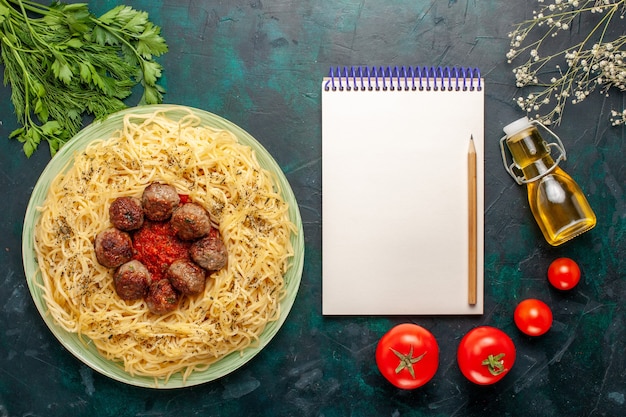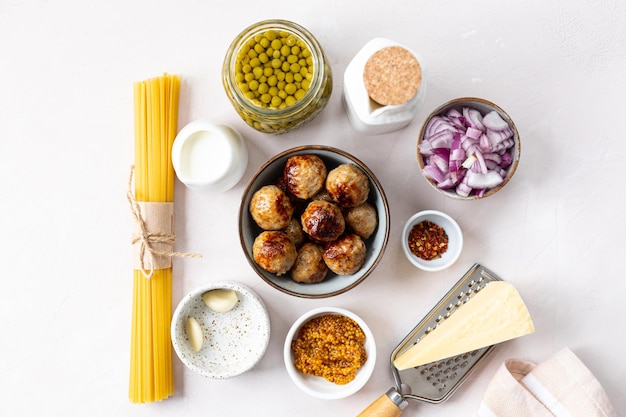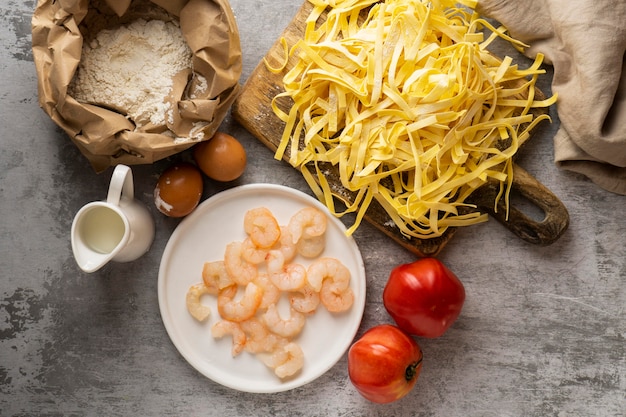Ah, spaghetti meatballs. Just the name conjures up warm, comforting memories of family dinners, hearty portions, and that irresistible blend of savory flavors. They're more than just a dish; they're a culinary hug in a bowl, a taste of home, and a testament to the magic of simple, well-executed cooking.
Over the years, I've had my fair share of meatball experiences, from the dry and crumbly to the incredibly juicy and flavorful. I've learned that the key to a perfect meatball isn't some secret ingredient, but rather a combination of good quality ingredients, a little bit of know-how, and a whole lot of love.
So, grab a comfy chair, a glass of red wine (optional, but highly recommended), and let me walk you through my ultimate guide to crafting those perfect spaghetti meatballs that'll have everyone begging for seconds.
(Part 1) The Meat Matters: The Foundation of Flavor

Let's get down to the basics. The meat is the foundation of your meatball, and choosing the right blend is crucial. I'm a firm believer in the classic trio: ground beef, pork, and veal. This mix creates a symphony of flavors, with the beef lending richness, the pork adding juiciness, and the veal contributing a delicate sweetness.
But don't be afraid to experiment! Lamb meatballs, especially with a touch of mint, are an absolute delight. Or, for a leaner option, go for an all-beef blend. The key is to find a balance that works for your taste and doesn't compromise on texture or flavor.
The Art of Grounding: choosing the right cuts
When it comes to the specific cuts, I usually opt for ground beef, pork, and veal, but feel free to branch out! Chuck, sirloin, or even ground lamb can be used, just ensure they are well-ground and not too coarse, or you'll end up with chunks of meat that might not cook evenly.
If you're on a budget, a combination of ground beef and ground pork is a solid option. Just make sure the beef is at least 80% lean for a flavorful, juicy result.
The Role of Fat: Moisture and Flavor
Many shy away from fat, but in the world of meatballs, it's your best friend. A touch of fat, whether from the meat itself or added in the form of pancetta or bacon, ensures that your meatballs stay moist and flavorful. It prevents them from drying out during cooking and adds a rich, savory depth.
A good rule of thumb is around 10% fat, but feel free to adjust to your preference. Just remember, less is more; you don't want your meatballs swimming in grease!
(Part 2) The Secret Sauce: Unleashing Flavorful Possibilities

Now, let's talk about the soul of the meatball—the sauce. This is your canvas for creativity, a chance to explore different flavor profiles and add depth to your dish.
The first step is deciding on your base. Will it be a traditional, rich tomato sauce, a creamy white sauce, or perhaps something spicier like an arrabbiata? Once you've got your base, you can start adding the ingredients that will transform it into a sauce masterpiece.
The Tomato Tango: Building a Classic Base
For a traditional tomato sauce, the star of the show is the tomato. I'm all about good quality canned tomatoes, and trust me, the difference in flavor is noticeable. Whole peeled tomatoes tend to be my go-to; they have a richer, more intense flavor than crushed tomatoes, though those work well in a pinch.
The key to a truly amazing tomato sauce is breaking down those tomatoes. You can do this by hand, using a potato masher for a more rustic texture, or by blending them in a food processor for a smoother consistency. The goal is to release the flavor of the tomato without losing the essential chunks that contribute texture and depth.
Once your tomato base is ready, it's time to layer on the flavor. I like to add a good quality tomato paste for extra richness, a touch of sugar to balance the acidity, and a bay leaf for a subtle, earthy note. A pinch of dried oregano or basil, depending on your preference, adds complexity. And don't forget the salt and pepper! They're essential for bringing out the best in all the ingredients.
The White Wine Whirlwind: Crafting a Creamy Delight
For a creamy white sauce, you'll need a good quality white wine. It's the foundation of the sauce, so don't skimp on it. I usually opt for a dry white wine, like Sauvignon Blanc or Pinot Grigio, but feel free to experiment with different varieties.
Next, you'll need heavy cream, which is the key to that luscious, velvety texture. Aim for full-fat cream for the richest flavor. Start by simmering the white wine until it reduces slightly, then add the cream and continue simmering until the sauce thickens.
For extra flavor, add a pinch of nutmeg, a sprinkle of Parmesan cheese, or even some chopped fresh herbs. Just remember, less is more; let the creaminess shine through.
(Part 3) Mixing it Up: Creating a Flavorful Meatball Base

Now that you've got your meat and your sauce sorted, let's get to the fun part: mixing the meatball base. This is where all the flavors come together to create something truly delicious.
I like to start by combining all the meat in a large bowl. Then, I add in my aromatics, which are the backbone of flavor: garlic, onion, and a pinch of red pepper flakes for a touch of heat. Next comes the breadcrumbs, which help to bind the meatballs and give them that satisfyingly fluffy texture. A sprinkle of grated Parmesan cheese adds a cheesy richness and helps create a lovely crust.
But hold on! Don't stop there. You can add a variety of other goodies to your meatball mix, depending on your taste. A touch of chopped parsley, a splash of milk, a squeeze of lemon juice, or even a bit of finely chopped pancetta—the possibilities are endless. Just remember, the goal is to enhance the flavors of the meat, not overwhelm them.
The Secret Ingredient: Breadcrumbs
Breadcrumbs are a vital ingredient in any good meatball recipe. They add texture and moisture, bind the meatballs together, and prevent them from falling apart during cooking.
While you can use store-bought breadcrumbs, I prefer to make my own, as it allows me to control the texture and ensure freshness. Simply take a few slices of bread, remove the crusts, and pulse them in a food processor until they're finely ground.
If you're looking for a more flavorful option, try seasoned breadcrumbs, which often contain herbs and spices. Or, for a bit of a crunch, use panko breadcrumbs, which are Japanese breadcrumbs known for their crispy texture.
The Power of Garlic and Onion: The Aromatics
Garlic and onion are the unsung heroes of a good meatball. They add a depth of flavor and a heavenly aroma that'll fill your kitchen with the promise of deliciousness.
Fresh garlic is my preference, as it has a more intense, vibrant flavor. But if you're short on time, jarred garlic paste will do the trick. For the onion, I like to use a combination of yellow and white onions. They both contribute different nuances of flavor, making the overall taste richer and more complex.
The Spice of Life: Red Pepper Flakes
A pinch of red pepper flakes adds a touch of heat and complexity to your meatballs. Just a small amount is all you need, as you don't want to overpower the other flavors. If you're not into spicy food, feel free to leave it out.
(Part 4) The Art of the Ball: Forming meatball masterpieces
So, you've got your delicious meatball mix ready to go. Now comes the art of forming those little culinary masterpieces. This might seem like a simple step, but it's actually crucial to the final result.
I like to use a spoon to scoop out small portions of the meatball mix, then gently roll them into balls using my hands. This method helps to keep the meatballs nice and even, ensuring that they cook through properly.
But hey, don't be afraid to experiment! You can use a cookie scoop, a small ice cream scoop, or even your hands. Find a method that works for you and yields those perfectly round, evenly shaped meatballs.
The Importance of Size: Finding the Perfect Balance
The size of your meatballs is crucial. Too big, and they might not cook through. Too small, and they'll dry out quickly. I find that meatballs about the size of a golf ball are ideal.
If you're making a large batch, you might want to opt for slightly smaller meatballs to ensure they cook evenly throughout. It's all about finding the perfect balance for your needs.
The Gentle Touch: Handling the Meatballs
When handling your meatballs, be gentle. You don't want to overwork the meat, as this will make them tough. Use a light touch, gently shaping them into balls.
If the meatball mix is sticking to your hands, simply wet them with a bit of water or use a touch of olive oil to prevent sticking.
(Part 5) Cooking to Perfection: Achieving a Golden Brown Crust
Your meatballs are formed, and now it's time to get them cooking. This is the moment where you'll create that irresistible golden brown crust and lock in all those delicious flavors.
My preferred method is pan-frying in a large skillet over medium heat. I use a combination of olive oil and butter, which gives the meatballs a rich, buttery flavor and that beautiful golden crust.
Don't overcrowd the pan! Give the meatballs enough space to brown properly on all sides. And remember, patience is key. You want to cook them slowly, allowing the heat to penetrate the center without burning the outside.
The Perfect Pan-Fry: A Crispy Crust
Heat your skillet over medium heat. Add a tablespoon of olive oil and a knob of butter. Once the butter has melted and the oil is shimmering, you're ready to add your meatballs.
Don't overcrowd the pan! Give them space to brown properly. Cook them for about 5-7 minutes per side, or until they are golden brown and cooked through. You can test for doneness by cutting one open with a knife; the meat should be cooked through, with no pink left.
The Oven's Embrace: A Gentle Bake
If you prefer a more hands-off approach, baking your meatballs is a great option. Preheat your oven to 375°F (190°C). Place the meatballs in a baking dish, drizzle them with a little bit of olive oil, and sprinkle with Italian seasoning. Bake for 20-25 minutes, or until they're cooked through and golden brown.
Baking is especially helpful for large batches, as it ensures even cooking and prevents sticking.
(Part 6) The Sauce Symphony: Bringing it All Together
Your meatballs are cooked to perfection, and now it's time to introduce the star of the show: the sauce. This is where all the flavors come together in a symphony of deliciousness.
If you've pan-fried your meatballs, you can simply add the sauce directly to the pan. If you've baked them, transfer them to a large pot or dutch oven. Add your sauce, bring it to a simmer, and allow the meatballs to cook in the sauce for about 15 minutes, or until they're heated through.
As the meatballs simmer in the sauce, they'll absorb the amazing flavors, creating a truly irresistible dish.
The Art of Simmering: Infusing Flavor
Simmering the meatballs in the sauce is essential. It allows the flavors to meld, the sauce to thicken slightly, and the meatballs to become incredibly tender and juicy.
Keep the heat low, just barely bubbling. Don't let the sauce come to a boil, as this could make the meatballs tough.
The Finishing Touch: A Sprinkle of Parmesan
Once the meatballs are cooked through and the sauce has thickened, it's time for the final flourish: a sprinkle of freshly grated Parmesan cheese. It adds a touch of salty richness and a wonderful aroma, taking the dish to the next level.
If you're feeling fancy, add a pinch of chopped fresh parsley or basil for a vibrant, fresh flavor.
(Part 7) The Spaghetti Sidekick: Making it a Complete Meal
Now, let's talk about the perfect companion to your meatballs: spaghetti. It's the classic pairing for a reason! It's simple, satisfying, and the ideal way to soak up all that delicious sauce.
I like to cook my spaghetti al dente, meaning it's still slightly firm to the bite. This ensures it holds up well to the sauce and meatballs. And don't forget to reserve some of the pasta water! It's a secret weapon for creating a smooth, creamy sauce.
The Art of Al Dente: perfect pasta
Bring a large pot of salted water to a rolling boil. Add the spaghetti and cook according to the package instructions, but aim for al dente. This means the pasta should be cooked through but still have a slight bite to it.
You can test for al dente by tasting a piece of pasta; it should be cooked through but still have a little bit of resistance.
The Pasta Water Trick: Creamy Perfection
Once the spaghetti is cooked, drain it, reserving about a cup of the pasta water. The starchy water is a secret weapon for creating a silky, smooth sauce. Add a few tablespoons of the pasta water to your sauce and stir until it's combined. The starch will help thicken the sauce and make it incredibly creamy.
(Part 8) Serving Up Your Culinary Creation: A Feast for the Senses
The moment has arrived. Your meatballs are simmered to perfection, the spaghetti is cooked al dente, and the sauce is simmering beautifully. Now it's time to assemble your culinary masterpiece and enjoy a feast for the senses.
I like to serve my meatballs and spaghetti in a shallow bowl or on a plate. I layer the spaghetti first, then spoon over the meatballs, making sure they're generously coated in sauce.
A final sprinkle of Parmesan cheese, a garnish of fresh basil, and a drizzle of olive oil are the perfect finishing touches. And don't forget the crusty bread for soaking up any leftover sauce—it's a must!
The Tablescape: Setting the Scene
A well-set table can enhance the dining experience. Use a tablecloth in a color that complements the dish, and placemats that add a touch of elegance. Choose napkins that are soft and absorbent. And don't forget the wine glasses! A good glass of red wine pairs perfectly with spaghetti meatballs.
The Gathering: Sharing with Loved Ones
Spaghetti meatballs are a dish best enjoyed with loved ones. Gather your family and friends around the table, and let the laughter and conversation flow. This is a dish that brings people together, creates warm memories, and makes even the simplest of gatherings feel special.
FAQs
Now, I know you might have some questions about making the ultimate spaghetti meatballs. Here are a few frequently asked questions and their answers.
- Q: Can I freeze spaghetti meatballs?
- A: Absolutely! Frozen spaghetti meatballs are a lifesaver for busy nights. You can freeze them raw or cooked, just make sure to place them in freezer-safe bags or containers. For best results, freeze them individually so you can grab just the amount you need.
- Q: What kind of cheese should I use for my meatballs?
- A: Parmesan cheese is the classic choice, but feel free to experiment! Pecorino romano adds a sharp, salty flavor, and you can even try a blend of cheeses for added complexity.
- Q: How long do spaghetti meatballs last in the fridge?
- A: Cooked spaghetti meatballs can be stored in the fridge for 3-4 days in an airtight container. For optimal freshness, refrigerate them as soon as they cool down.
- Q: What can I serve with spaghetti meatballs?
- A: Besides classic spaghetti, you can also serve your meatballs with other pasta shapes, such as rigatoni, penne, or fettuccine. Get creative! Serve them over rice, polenta, or even mashed potatoes for a twist on the traditional.
- Q: How do I make spaghetti meatballs vegetarian?
- A: You can make delicious vegetarian meatballs using a mixture of lentils, mushrooms, and breadcrumbs. There are many great recipes available online, so feel free to explore!
I hope this guide has been helpful. Remember, the key to perfect spaghetti meatballs is to have fun and experiment. Don't be afraid to try different ingredients, flavors, and techniques. And most importantly, enjoy the process! Making spaghetti meatballs is a labor of love, and the results are well worth the effort. So, gather your loved ones, put on some music, and let's get cooking!
Everyone is watching

Corn on the Cob: The Ultimate Guide to Perfectly Cooked Ears
Healthy MealsAh, corn on the cob. Just the name evokes images of sunny days, barbecues, and that sweet, juicy flavour that ...

Perfect Pork Roast Oven Cooking Time: A Guide to Delicious Results
Healthy MealsThere's something truly satisfying about a perfectly roasted pork. The aroma alone is enough to make your mout...

Ham Cooking Time: How Long to Bake, Smoke, or Boil a Delicious Ham
Healthy MealsAh, ham. It's a classic, isn't it? A real crowd-pleaser, especially around holidays. And when done right, it'...

Scallops: The Ultimate Guide to Perfect Cooking
Healthy MealsAh, scallops. Those delicate, sweet, and utterly delicious morsels of the sea. They hold a special place in my...

Spaghetti Squash: The Ultimate Guide to Cooking and Serving
Healthy MealsRemember that time you saw spaghetti squash at the supermarket, looking all bumpy and strange, and thought, "W...
